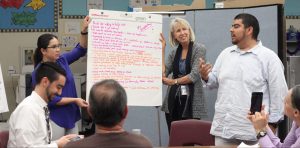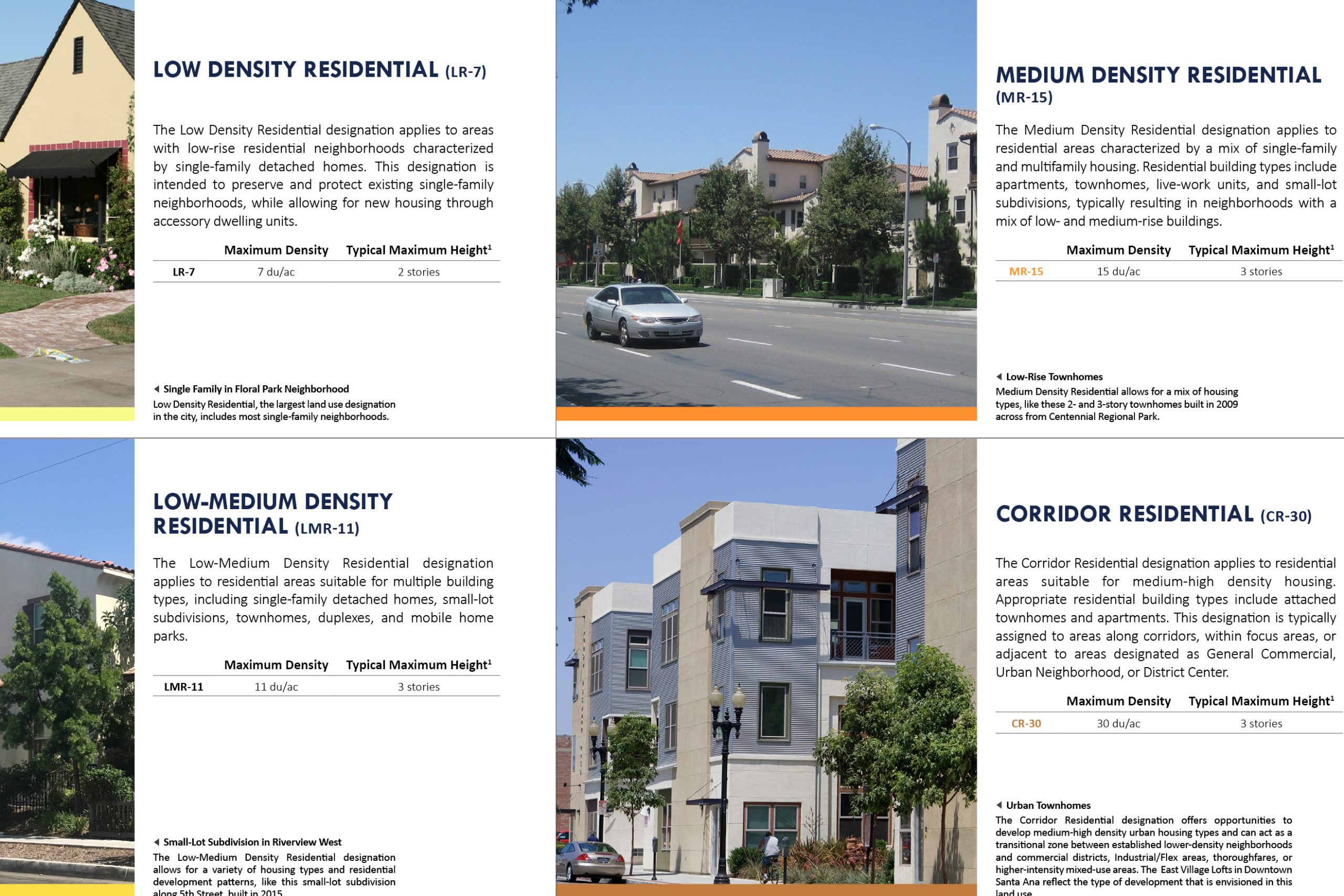|
Ref #
|
Implementation Action
|
Agency /
Time Frame
|
| GOAL LU-3: Preserve and improve the character and integrity of existing neighborhoods and districts. |
| 3.1 |
CEQA review. Continue to evaluate land use compatibility through required environmental clearance of new development projects. |
PBA
Ongoing |
3.2  |
Design guidelines and standards. Update the zoning code’s development and operational standards for industrial zones to address incompatibility with adjacent uses, including minimum distance requirements to buffer heavy industrial uses from sensitive receptors. Conduct a study to evaluate and establish appropriate minimum distances and landscape buffers between polluting industrial uses from sensitive receptors such as residences, schools, day care, and public facilities. |
PBA
2022-2027 |
3.3  |
Healthy lifestyles. Collaborate with residents and industry stakeholders to create a program to incentivize and amortize the removal of existing heavy industrial uses adjacent to sensitive uses. |
PBA
2022 |
3.4  |
Funding for air filtration. Seek funding from South Coast Air Quality Management District and other regional sources for the installation of high-efficiency air filtration systems in buildings, homes, and schools located in areas with high levels of localized air pollution, especially for those within environmental justice area boundaries. |
PBA
2022 |
3.5  |
Business incentive. Explore economic development incentives and grant funding to encourage existing or draw new business investments in the industrial zones to incorporate more environmentally sustainable practices. |
CDA
Ongoing |
3.6  |
Lead paint abatement. Coordinate with County of Orange Health Care Agency and community organizations to strengthen local programs and initiatives to eliminate lead-based paint hazards, with priority given to residential buildings located within environmental justice area boundaries. |
CDA/PBA
2021 & Ongoing |
| 3.7 |
Building massing. Update the Citywide Design Guidelines to incorporate best practices addressing transitions in building height and bulk for new development adjacent to lower density neighborhoods. |
PBA
2022 -2027 |
| 3.8 |
Signage. Update the sign ordinance to incorporate measures that reduce visual clutter. |
PBA
2022 -2027 |
| 3.9 |
Parking. Through City Interagency collaboration, develop parking management strategies to support the Land Use Plan and reduce dependency on single-passenger vehicles, considering the parking needs for existing development and future activity nodes, changes in automotive technologies and car usage trends, and options for City-operated facilities. Explore parking strategies through pilot projects. |
PBA/ PWA
2022 |
| 3.10 |
Code enforcement. Continue aggressive code enforcement programs and activities to maintain community pride and promote reinvestment in Santa Ana neighborhoods. |
PBA
Ongoing |
| 3.11 |
Neighborhood aesthetics. Partner with neighborhood associations to provide educational materials to residents regarding the front yard, parkway, landscape, and fence requirements. |
PBA
2022 & Ongoing |
| 3.12 |
Adaptive reuse. Update the Adaptive Reuse Ordinance to clarify the areas of opportunity for conversion to new housing. |
PBA
2022 -2027 |
| 3.13 |
Growth in focus areas. Develop incentives to promote development within identified focus areas. |
PBA/CDA
2022 |
3.14  |
Sunshine ordinance. Update City Sunshine Ordinance, incorporating best practices for outreach in environmental justice areas in Santa Ana. |
CMO
2022 |
3.15  |
Communication tools. Explore tools for communication with residents and sensitive receptors when new industrial uses are proposed in their areas. |
PBA
2022 -2024 |
3.16  |
Health in corridors. Require a Health Risk Assessment to identify best practices to minimize air quality and noise impacts when considering new residential uses within 500 feet of a freeway. |
PBA
2022 -2027 |
3.17  |
Training for safe practice. Pursue the EPA Renovate Right Program to train local residential contractors for certification as lead renovators to promote safe work practices and prevent lead contamination. |
PBA
2022 |
3.18  |
Renovations and lead prevention. Evaluate the feasibility of requiring contractor training and/or certification for safe work practices to conduct residential renovations for pre-1978 structures that may contain existing lead paint. |
PBA & CDA Ongoing |
3.19  |
Promote health. Partner with local organizations (e.g., OC Health Care Agency, Latino Health Access, Santa Ana Unified School District, Garden Grove Unified School District, Orange County Environmental Justice, and the Coalition of Community Health Centers) to increase blood lead testing, outreach, education, and referral services through a ‘promotora’ or community peer outreach model that addresses the root causes of elevated blood lead levels impacting Santa Ana residents, with special focus in environmental justice communities and for children living in pre-1978 housing. |
PBA
2022 & Ongoing |
3.20  |
Safe housing. Require all residential rehabilitation projects that use local, or HUD federal funds to comply with the Lead Safe Housing Rule, to remove lead paint hazards, depending on the nature of work and the dollar amount of federal investment in the property. |
CDA
Ongoing |
3.21  |
Prevention education. Collaborate with local organizations such as Orange County Health Care Agency, State Environmental Protection Agency, and community-based environmental justice organizations to identify funds and create a Santa Ana Prevent Lead Poisoning Education Program, with special focus on disadvantaged communities and pre-1978 housing stock. |
PBA
2022 & Ongoing |
3.22  |
Public health outcomes. Support the Orange County Health Care Agency in their role in investigating public complaints regarding unsafe lead work practices and lead hazards wherein children are present, through enforcement of local housing standards to assure healthy outcomes, including for individuals and households presenting with concerns about lead exposure and/or with confirmed lead levels of >3.5 ug/dL, which the Centers for Disease Control and Prevention indicates as the threshold for follow-up and case management in children. |
PBA
2022 & Ongoing |
3.23  |
Agency permits. Work with South Coast Air Quality Management District and Orange County Health Care Agency to evaluate existing special permit process and criteria for approval, and identify potential policy changes to minimize issuance of special permits with potential health impacts. |
PBA
2022 |
3.24  |
Public health. Partner with Orange County Health Care Agency and community serving organizations to evaluate best practices and benefits of preparing a Public Health Plan to address environmental hazards in Santa Ana, with special focus in environmental justice communities. Conduct public meetings to gather information and present preliminary findings. |
PBA
2022 -2024 |
3.25  |
Engage EJ communities. Work with community serving organizations, neighborhood leaders, and residents to form an Environmental Justice Action Committee to develop ongoing EJ Community Engagement programs for existing and new disadvantaged EJ communities, including multilingual communication protocols. Host quarterly Roundtable meetings with local stakeholders to guide and evaluate implementation of environmental justice policies. |
PBA
2022 |
3.26  |
Health conditions. Work with state agencies including the Department of Toxic Substances Control and South Coast Air Quality Management District, Orange County Health Care Agency and local stakeholders including Orange County Environmental Justice and UC Irvine Public Health to identify baseline conditions for soil and air contamination in Santa Ana, routinely monitor indicators of such contamination, and measure positive outcomes. Collaborate with these organizations to secure grant funds for soil and air testing, remediation (e.g., bioremediation, covering, removing, air filtration), and prevention activities for residential properties in proximity to sites identified with high levels of soil pollution (including sites identified with soil lead levels of 80 ppm or higher) and air pollution, with a focus on communities disproportionately affected by soil contamination. |
PBA
Ongoing |
3.27  |
Groundwater practice. Coordinate with the State Department of Toxic Substances Control (DTSC) to monitor the Santa Ana Southeast Groundwater Clean Up Project and identify measurable progress to remediate groundwater contamination. Share information with the community on the City’s Environmental Quality web page. |
PBA
Ongoing |
3.28  |
Tenant protections. Provide information to residential tenants regarding Landlord Tenant Laws in the State, such as AB 1481, and Santa Ana’s Just Cause for Tenant Eviction and Rent Stabilization ordinance that provide protections against evictions for those who seek action to improve substandard housing and hazardous conditions. |
PBA
2022 & Ongoing |
3.29  |
Development site history. Update the City’s Development Review application process to require developers to provide information regarding the prior use of the site and history of hazardous materials on the property, in order to identify potential for site contamination from hazardous materials or soil lead contamination to be remediated. |
PBA
2022 |
Notes:
CDA – Community Development Agency; CMO – City Manager’s Office; HR – Human Resources Department; PBA – Planning and Building Agency; PWA – Public Works Agency; PRCSA – Parks, Recreation and Community Services Agency; PD – Police Department
 associated with environmental justice policies associated with environmental justice policies |










